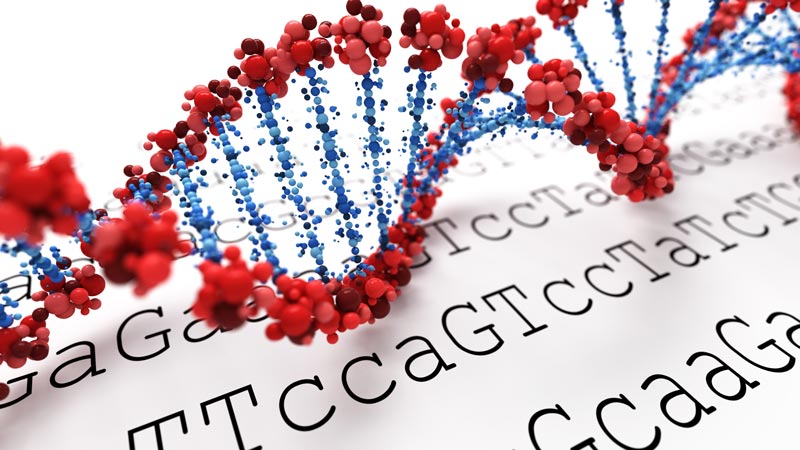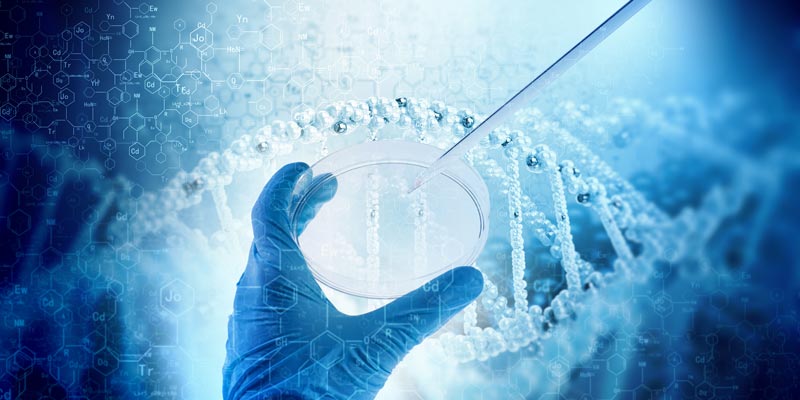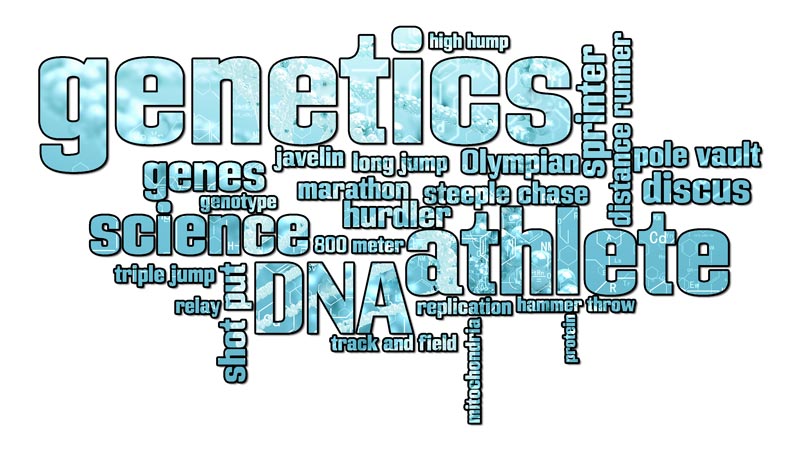
It is often said that elite athletes are born and not made. This indicates that there is a large genetic component to sporting performance, which anecdotally can be seen in many examples. Both my parents were reasonably good sprinters, for example, and it turns out I wasn’t too bad either. Many studies have looked at the inheritability of athletic traits, and estimates for how much sporting ability is inherited ranges from 20% up to 70%, depending on the sporting skill required. It appears that for physiology-based sports, such as athletics, the genetic aspect is higher than in skill-based sports where different roles can be fulfilled by different people. For example, a sprinter will always need to be fast, while an elite soccer player can be quick, have good endurance or a mix of the two. Understanding the genetic component to sporting success can lead to better training programs, more efficient training and potentially increased success.
What are genes?
First we need to understand what genes are. Genes are where we store our DNA, and this DNA allows us to create proteins that have certain functions, or create certain traits. For example, a set of genes create the protein for eye colour, and the difference in these genes between individuals leads to differences in eye colour. The long strands of DNA that make up our genes are comprised of four different bases; A, C, G and T. Sometimes, in the process of DNA replication, one of these bases is accidentally substituted for another. The substitution creates a single nucleotide polymorphism or SNP. The SNP can either have no effect on which amino acid sequence is created (making it a synonymous SNP) or change the amino acid sequence, which is called a non-synonymous SNP. There are two types of non-synonymous SNPs, nonsense and missense. Nonsense SNP is one that causes a stop codon to be created, and the result of this is that an incomplete protein is transcribed. This incomplete protein tends to be non-functional and ineffective. A missense SNP is where a different amino acid is coded, which changes the function of the protein. As an example, sickle cell disease usually results in a change from GAG to GTG where the A is substituted to a T. This single change results in valine being created instead of glutamic acid, and the end result is that the individual develops sickle cell disease. Studying these SNPs in relation to sporting performance is an emerging field with encouraging results.

One thing to remember is the effect of the environment on our genes. Having the best genes is not enough for sporting performance; an ideal environment is also critical. As an example let’s imagine that somewhere in rural China lives a young boy. This boy has incredible sprint genes, much better than Usain Bolt. However, he doesn’t know athletics exists, let alone take part. His day is spent farming in the fields in order to make money to survive. Despite his perfect genes, he will never be a rival to Usain Bolt. Now let’s consider a 12-year-old boy growing up in Jamaica. He shows some promise in sprint races at school, and so goes along to an athletics club. Here, he receives training from an expert coach who has plenty of experience in taking sprinters from decent school athletes to Olympic champions. He joins a training group that has a number of high-level sprinters, and every day is pushed to have good training sessions by these partners. He is exposed to sensible competitions, and as such learns to compete well controlling his nerves and raising his performance when it matters. This athlete develops within an exceptional environmental system that places him at an advantage regardless of what his genes are. In fact, compared to his Chinese counterpart, this Jamaican might only need to have better than average sprint genes to succeed.
We also need to consider the role that other heritable traits play in sporting success. Consider another sprint example. An individual with perfect sprint genes who is only 4 foot tall would never be Olympic Champion because they would lack the stride length required to be a great sprinter. Remembering this interplay is important when considering which genes allow elite sporting performance.
What do the studies show?
The next thing to consider is how the science is done. At the moment, most of the gene studies are association studies. This means that scientists get a group of elite athletes, and a group of control athletes/non-athletes, and see what difference there is genetically between the groups. From this, scientists can then come up with a hypothesis regarding the genes that occur more or less frequently in the elite athlete group, and then test this hypothesis.
Let’s look at a particular gene to illustrate this example. The gene we are going to look at is alpha-actinin-3 or ACTN3 for short. ACTN3 is a good example because it is very well studied. There are three different types of ACTN3 genotype; RR, RX, and XX. I’ll discuss what this means later on, but it’s important to note that the difference between an R and an X allele is a substitution of one base, from C to T – this is the SNP that causes the differences. In a study by Yang et al. (2003), the scientists looked at 429 elite Australian athletes, and 436 Australian controls. They further split the elite athletes in two groups; athletes involved in speed-power sports, or athletes involved in endurance sports. They then looked at the difference in the ACTN3 genotype between the groups. What they found is that elite speed-power athletes were more likely to have the RR genotype than both the controls and endurance group. Conversely, the endurance group were more likely to have the XX genotype than either the controls or the speed power group. The XX genotype was present in 24% of endurance athletes, 18% of controls, and only 6% of elite speed-power athletes. Interestingly, this study included sprinters that had been to the Olympic Games; none of them had the XX genotype. The conclusion from this study was that the RR genotype is linked to elite performance in speed-power events, and the XX genotype was linked to elite performance in endurance events.

These results are similar to that of other studies. A study by Massidda et al. (2012) found that the RR genotype was linked to elite gymnastics status. Moran et al. (2006) found that the R allele was associated with improved sprint performance in Greek adolescents. Scott et al. (2010) reported that in elite US and Jamaican sprinters, the XX genotype only occurred in about 3% of athletes.
From these interesting results, scientists could then propose a model for why ACTN3 genotype creates these effects. In a review article in 2013 by Eynon et al. (2013), the authors describe how ACTN3 codes for a protein found only in type-IIx muscle fibres. Individuals with the XX genotype cannot create this protein, which shifts muscle fibres towards the slower twitch end of the spectrum. Individuals with the RX genotype (i.e. one allele of each) can produce some type IIx fibres, and individuals with the RR genotype can produce the most. Eynon describes a mouse knockout model, in which mice were bred to have the XX ACTN3 genotype. These mice had less muscle mass (due to a decreased diameter of type IIx fibres), less grip strength (however you may test grip strength in a mouse) and an increased endurance capacity compared to RR and RX genotyped mice. These results mirror that of Vincent et al. (2007), which show that individuals that are RR for ACTN3 have around 5% more type-IIx fibres than those with the XX genotype.
Once an understanding of ACTN3 and how it affects performance was formulated, it was time for scientists to put this to the test. Delmonico et al. (2007) found that when a group of individuals were given the same training programme, those that had the RR genotype saw greater improvements in peak power and absolute power relative to both RX and XX genotypes. In turn, the RX genotypes saw greater improvements than the XX group. Similarly, Turky et al. (2014) found that in a group of youth weightlifters doing the same twelve week training programme, individuals with the RR genotype showed the greatest improvement in peak strength, whereas individuals with XX showed the greatest improvements in strength endurance. Interestingly, Ahmetov et al. (2014) found that ACTN3 genotype was also linked to resting testosterone levels in elite Russian athletes; individuals with RR genotype had greater free testosterone than those with the RX genotype who in turn had greater levels than those with the XX genotype. Norman et al. (2014) also found that mTOR activity was lower in individuals of XX genotype following sprint training; mTOR is an enzyme that plays a role in muscle hypertrophy.
So, from all the data, we can conclude that individuals with the RR genotype should respond to power based training to a greater extent than those with the RX genotype who in turn will respond better to power based training than those with the XX genotype. The mechanism for this is likely to be down to adaptations in the type-IIx fibres, of which the XX genotype doesn’t have as much. Additional mechanisms are likely to be related to testosterone levels, as well as mTOR signalling.
There are plenty of other genes linked to exercise performance and response to exercise. Along with the ACTN3 gene already discussed, the ACE gene is strongly linked to both power and endurance exercise. Individuals with the DD version of this gene tend to respond best to power training, whilst those with the II version respond best to endurance training. In a study on 91 British Olympic standard runners, the I allele increased in frequency as the distance ran increased. This indicates that the II genotype was much more prevalent in elite endurance athletes and much less prevalent in elite sprint athletes (Myerson et al. 1999). These results are mirrored in groups of Australian Olympic rowers, Russian endurance athletes, and elite South African Ironman triathletes (Puthucheary et al., 2011). The BK2BR gene is also linked to response to exercise, with the DD genotype occurring with a greater frequency in endurance athletes. Other potential sporting genes include AGT (C allele over-represented in elite power athletes), AMPD1 (CT allele present in a higher frequency of power compared to endurance athletes), Il-6 (G allele more frequent in power athletes compared to endurance athletes), and genes linked to mitochondrial response to exercise including PPARA, PPARD, PPARG, and PPARGC1A (Lucia et al., 2005; Eynon et al., 2013).
There are also a growing number of genes linked to injury risk. Up to 50% of sporting injuries involve tendons (Collins & Raleigh, 2009), and collagen is a major structural component of these tendons. Genes that code for Type I collagen (COL5A1) and Type V collagen (COL5A1) have been shown to influence injury risk. For example, individuals with the TT genotype of COL1A1 are at a decreased risk of Achilles tendon or anterior cruciate ligament (ACL) injury. Indeed, in a study on South Africans, Collins et al. (2010) found that the TT genotype was present in only 0.3% of ACL injury despite the fact that almost 5% of the tested population had this genotype.
So what does this all mean for the athlete?
All this information is interesting, but is it useful for the athlete and coach? This field is a new and emerging science, and so it is important to consider this when interpreting genetic information. Grimaldi et al. (2012) discuss some issues in their paper, including the fact that genetic studies often cannot limit or determine the environmental influence. However, evidence is starting to emerge that allows guidance to be given to athletes who have had their genome tested. For example, going back to ACTN3, we now know from the studies that individuals with the RR genotype will respond to power training to a greater extent than those with the XX genotype. Therefore, if we get an RR individual, we would recommend that their training biases power work a bit more. If we get an XX individual, we will recommend that an individual bias a higher rep range in the gym, including repetitions to failure (in exercises where that is safe to do so). Similarly, RR individuals are likely to benefit from high-intensity sprint training over short distances, whilst RX (the mix genotype) might respond better to speed endurance work. These differences in muscle architecture and fibre type are created by the differences in this gene.
Similarly, individuals whose genes show that they are more efficient at creating new blood vessels within the muscle and who are more likely to have efficient mitochondrial biogenesis will respond well to endurance based running training. Note that if this individual were a sprinter, they shouldn’t be told that they should become a 5000m runner – clearly this would be absurd. Instead, they should consider the fact that they might get more out of shorter recovery training than other individuals.

With regards to injury risk, individuals that score highly on this would be placed on an effective pre-habilitation programme, involving eccentric loading of at risk tendons. Over the course of a training or competition block, these athletes will be closely monitored for injury symptoms and might spend more time undergoing recovery modalities. FC Barcelona now screen their players for genetic risk factors thought to be associated with hamstring injuries and use it as a part of their pre-habilitation techniques (Til et al., 2013).
Having had my genetics tested, I can tell you that the results didn’t surprise me. It showed that I had a slight endurance bias, which made sense to me – as a sprinter I didn’t tolerate high-speed work particularly well, and responded really well to slightly longer distance reps. My favourite session used to be 5x200m, and I was much better at 300/150m repetitions that my training partners. In the gym, my one repetition maximums are not all that impressive, but my 5 repetition maximums are relatively much better. In terms of injury, I received the highest injury risk score that the company testing me had seen. Again, this isn’t all that surprising; intervertebral discs are comprised of collagen, and I have suffered numerous disc injuries throughout my career. However, since I was 17 I have had a really good rehab and pre-hab training programme in place, which has allowed me to minimize the disruption these injuries caused me as much as possible. This illustrates the utility of these tests; knowing that you are at an increased risk of injury allows the athlete and coach to modify their environment to reduce this risk. It could also improve adherence to an injury prevention program.
So what does all this mean? Genetic testing isn’t a magic bullet. Instead, it is a useful tool that enables you to base your decisions based on evidence. It can also remove trial and error that can cost an athlete time and success. Had I tested my genes when I was 18, it could have prevented years of trying the wrong training and diet, and instead put me on the right track earlier. As more and more studies are completed, personalised training and nutrition programmes for high-level athletes will become much more common. We already know that one-size doesn’t fit all; now we can say which training type suits which individual.
Please share this article so others may benefit.
[mashshare]References
Ahmetov et al. (2014). ACTN3 genotype is associated with testosterone levels of athletes. Biol Sport 31(2) 105-108
Collins et al. (2010). The COL1A1 gene and acute soft tissue ruptures. Br J Sports Med 44(14) 1063-1064
Collins & Raleigh (2009). Genetic risk factors for musculoskeletal soft tissue injuries. Med Sport Sci 54 136-149
Delmonico et al. (2007). Alpha-actinin-3 (ACTN3) R577X polymorphism influences knee extensor peak power response to strength training in older men and women. J Gerontiol A Biol Sci Med Sci 62(2) 206-12
Eynon et al. (2013). Genes for elite power and sprint performance: ACTN3 leads the way. Sports Med 43(9) 803-17
Grimaldi et al. (2012). Personal genetics – Sports utility vehicle? Recent Pat DNA Gene Seq 6(3) 209-215
Lucia et al. (2005). PPARGC1A genotype (Gly482Ser) predicts exceptional endurance capacity in European men. J Appl Physiol 99(1) 344-348
Massidda et al. (2012). ACTN3 and ACE genotypes in elite male Italian athletes. Anthropoligcal Review 75(1) 51-59
Moran et al. (2006). Association of the ACTN3 R577X polymorphism and complex quantitative body composition and performance phenotypes in adolescent Greeks. Eur J Hum Genet 15(1) 88-93
Myerson et al. (1999). Human angiotensin I-converting enzyme gene and endurance performance. J Appl Physiol 87(4) 1313-1316
Norman et al. (2014). ACTN3 genotype and modulation of skeletal muscle response to exercise in human subjects. J Appl Physiol 116(9) 1197-1203
Puthucheary et al. (2011). The ACE gene and human performance: 12 years on. Sports Medicine 41(6) 433-448.
Scott et al. (2010). ACTN3 and ACE genotypes in elite Jamaican and US sprinters. Med Sci Sport Exercise 42(1) 107-112
Til et al. (2013). Hamstring injuries in football: Applying scientific knowledge to daily on-field practice. Aspetar Sports Medicine Journal 2
Turky et al. (2014). Effect of training programme in terms of ACTN3 gene alleles on strength achievement, endurance and snatch for young weightlifters. International Journal of Advanced Sport Science Research 2(3) 280-288
Vincent et al. (2007). ACTN3 (R577X) genotype is associated with fibre type distribution. Physiol Genomics 32(1) 58-63
Yang et al. (2003). ACTN3 genotype is associated with human elite athletic performance. Am J Hum Genet 73(3) 627-631.


Don’t forget mentionning the concept of epigenetics and how our social interaction and our daily choices can trigger genes production.
Genetics is a based of probabilities, one can evolve outside of this scope still.
Very interesting!
From the data you discuss, you cannot conclude on what the program should be for a specific genotype. Indeed, the studies by Delmonico and Turky only show that the same training programme leads to different performance responses depending on the genotype. This is consistent with the genotyping of elite athletes of a sport, their elite status could be the result of a genetic predisposition but does not tell how they responded to training (in fact, their precise training programme is rarely/never reported in these studies). I mean we can only hypothesize about what training programme will lead to a maximal response in the performance of interest but such a study still has to be published, as far as I know.
Moreover, why should we try to boost a response that is already higher compared to other performances? If our success limited by the low-response performances, we could instead devote more time to train them and less in our high-response performances and have an overall advantage over our competitiors. This is the old question of training weaknesses VS assets, and putting more efforts in training assets might only be advantageous for well-experienced athletes that reach a plateau in progress and can only improve their high-response performances.
Hi Jonathan, thanks for your comments.
Regarding strengths vs weaknesses – if we know how well we will respond to a particular stimulus, then it makes sense to focus on that response. For example, if individuals with ACTN3 XX don’t respond as well to lifting heavy weights, it seems illogical to focus on lifting heavy weights, particularly if there is a genetic/molecular reason for them not responding quite as well.
As far as research – watch this space! Very soon there will be research coming out that shows that those following a genetically matched training programme see greater improvements than those following a standard programme. Should be available within the next 3 months.
Also since I wrote this article over a year ago, this paper came out – http://www.ncbi.nlm.nih.gov/pmc/articles/PMC4624116/ – which you might find interesting!
Craig
Hi Craig,
thank you for the article. Only a proposal for genotype-based training but looking forward to see the ongoing study you mentioned!
I feel like I need to clarify my point. I agree with you it’s safe to assume that focussing on heavy weights is better if you’re ACTN3 RR and lower weights if you’re XX, in order to induce muscle hypertrophy. If we can predict how we will respond to training based on the genotype it’s a great training tool. However, I feel uncomfortable with how training advice (not specifically yours, in general I mean) is made, because it sometimes sounds like we should train different athletic qualities depending on the genotype, while we should train qualities based on the race specificities and the genotype could tell something about how we train these qualities.
Are you taking part in this research that should be available in a few months? What sport discipline is it?
Hi Craig,
Fascinating study. All of what you said rings true with me. I found I could run faster for longer than most as well as do very high reps at 80-85% of my 1-rep max but was never able to be elite in the power sport aspects despite working much harder than my cohorts. This study and my genetic coding would explain why.
I have a genetic “XX” or “TT” code.
I grew up playing basketball, football, and baseball. I got to 6’2 195 lbs in high school. 195 lb 1-rep bench but I could also bench 175 lbs 8x. Some issues probably with technique/shoulder involvement, but you get the idea. I could squat 415 lbs, run a 4.68 40 yard dash, 11.15 sec 100m, and 1-step vertical jump of 34 inches.
But further gains seemed to really stall out after that as I had a lot of ligament issues which led to injuries that required surgery (ankle reconstruction on both ankles) and by mid 30s (still trying to play explosive sports) that had back issues (two sequestered discs, diseconomies to follow).
Perhaps there’s something to be said about the ligaments and discs as well related to XX/TT genetics? I noticed you had some disc issues too.
That said, do you know what the “test” was that assessed your “injury risk score”?
Thanks!